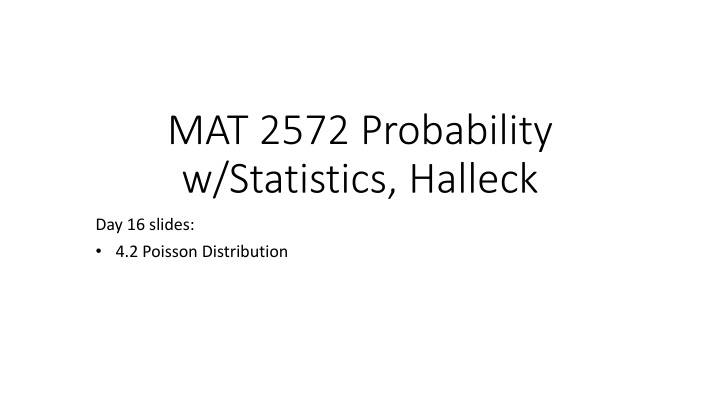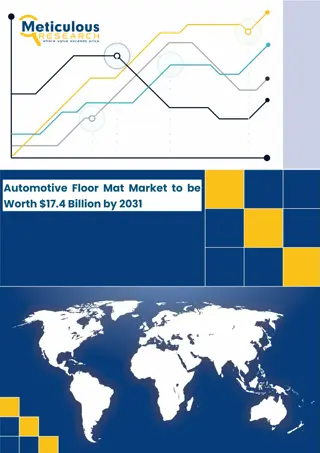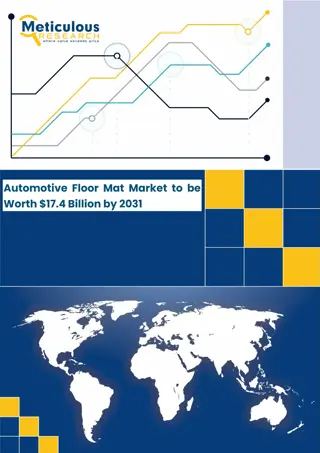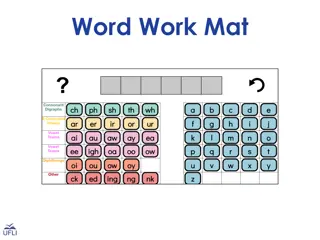
Poisson Distribution in Probability and Statistics
Explore the Poisson distribution as an approximation for binomial situations, learn how to prove the Poisson approximation formula, and discover binomial examples approximated by Poisson. Understand how Poisson can be used to model data and graph distributions for analysis and modeling purposes.
Download Presentation

Please find below an Image/Link to download the presentation.
The content on the website is provided AS IS for your information and personal use only. It may not be sold, licensed, or shared on other websites without obtaining consent from the author. If you encounter any issues during the download, it is possible that the publisher has removed the file from their server.
You are allowed to download the files provided on this website for personal or commercial use, subject to the condition that they are used lawfully. All files are the property of their respective owners.
The content on the website is provided AS IS for your information and personal use only. It may not be sold, licensed, or shared on other websites without obtaining consent from the author.
E N D
Presentation Transcript
MAT 2572 Probability w/Statistics, Halleck Day 16 slides: 4.2 Poisson Distribution
Poisson Distribution We often have a binomial situation where #trials n is large but the probability of a success p is small. If we let =np, then we can approximate the binomial distribution with a new distribution called Poisson: ? ? = ? ke ?! For fixed , this becomes a better approximation as n gets large and is exact in the limit. We would like to 1. Prove the last formula 2. Provide some binomial examples approximated by Poisson ,? = 0,1,2, . Note: Poisson is a distribution in its own right regardless of its binomial connection. ke k = e ?=0 ?!= e e = 1] [Clearly each probability is positive and ?=0 ?!
1. Proof of Poisson approximation of binomial ? ? pk?? ? lim ? ? ? = ? = lim = lim ? ? = k ?!lim = k ?!lim = ke ?! ? ? /?k1 /?? ? ? ? ? ? ?! ? ? ? !?? ? ? ? ?! ? ? ? !(? )? ? ? !(? )?= ke ?! lim ? ?! Last limit goes to 1: n(n 1) (n k +1) (n )(n ) (n )= is a finite product of ratios and each ratio goes to 1. n *n 1 n n n ?+1 n
Binomial example approximated by Poisson Every mile driven in a city has chance of 1 in 10,000 for a car accident as a result of someone else s careless driving. In a given year, you drive 2000 miles in the city without ever being careless. What is chance that you will have no accidents? Exactly 1 accident? More than 1 accident? Using binomial distribution P(0)=(9999/10000)2000 = 81.872% P(1)=2000(1/10000)(9999/10000)1999 = 16.376% P(>1) = 1 (81.9%+16.4%)=1.752% Using Poisson approx: =np= 2000(1/10,000)=1/5 & P(k)= ke /k! P(0)=e = e 0.2=81.873% P(1)= e = 16.375% P(>1) = 1 (81.9%+16.4%)=1.752%
More binomial examples approximated by Poisson. # of kids on a subway line on a particular day getting caught jumping turnstiles with no one around and no cameras. (1 in 1000?) # children born in NYC with Down s Syndrome in a given year to 30 year old mothers who are not tested (1 in 1000). #mistakes for a 1000 word essay (1 in 200). Number of people in a filled auditorium with a particular birth day (say June 21st, which is Poisson s!) Number of pieces of luggage lost by a frequent flyer over the course of 5 years (say 300 flights and every 200thchecked bags is lost).
How Poisson can be used to model 1. Use data (given as a table) to calculate mean ? = ? ? ? ?=0 2. On same set of axes, graph the data and the Poisson distribution using for the parameter . 3. If the fit is pretty close (expect some discrepancy due to randomness), then you found a good model. [Perhaps the next step is to figure out why (is there a binomial process behind the curtains?)]
#of bags lost frequency Problem 4.2.12 0 1 2 3 4 9 13 10 Weekly luggage losses by commuter airline (see excel file) 1. Using raw data, the frequency table is on right -> 2. Use table to get = 1.44 (~1 bags lost per wk) 3. Graph the data and the Poisson formula results on the same graph 4. It is pretty good fit, so we accept the model. 5. Next we ask: How are bags lost? Is there an underlying binomial process? 0.05 5 2 39 #bags lost/wk by small commuter airline 0.40 0.35 0.30 0.25 0.20 0.15 0.10 0.00 0 0.5 1 1.5 2 2.5 3 3.5 4 4.5 experimental poisson
Some criteria for Poisson 1. Do the events occur independently? 2. Does the probability that an event occurs during a given subinterval stay constant over the entire interval from 0 to T?
Examples and non-examples of Poisson. Example Non-example why # of clicks in a Geiger counter where the time interval is much less than half life # of clicks in a Geiger counter where the time interval is on the same order as the half life the chance of a click decreases over time as the radioactive part is lost #empty taxi cabs which pass a given corner late at night #busses arriving at a bus stop Busses tend to bunch up during rush hours and during non-rush hours, they are on a schedule #parties arriving at a restaurant during a prime time or during a non prime time #people arriving at a restaurant Especially during prime times, people tend to meet as a family, organization or friend unit #car accidents on a rural stretch of road under dry conditions at a certain hour of the day #car accidents in a stretch of road under all conditions Accident rate will depend on weather as well as the time of day and amount of traffic Exercise: come up with your own example and non-example!
Intervals Between Events: The Poisson/Exponential Relationship Poisson is a DISCRETE distribution. We are counting how many events happen in one interval. Here is what a typical time-line looks like: x f(x) 0 1 1 3 The data produced would be 1,1,2,1,0,3 for a frequency table: We can instead measure the TIME between events, indicated by the y s in the diagram: 1.6, 0.4, 0.6, 1.0, 1.4, 0.2, 0.4 2 1 3 1
Time between eruptions of Mauna Key (See Excel file) When graphing, do not use histogram for data. Instead, use DENSITY function: Divide each frequency by total #of data points and by width of each interval. Thus probability for an interval will correspond to the area under curve!
Exercise 4.2.27 Commercial airplane crashes in China occur at the rate of 2.5 per yr. 1. Give 2 reasons for assuming that such crashes are Poisson events and 2 reasons that question the use of Poisson. 2. What is the probability that four or more crashes will occur next year? 3. What is the probability that the next two crashes will occur within three months of one another?
Exercise 4.2.27 (cont.) Commercial airplane crashes in China occur at the rate of 2.5 per yr. 1. Give 2 reasons for assuming that such crashes are Poisson events and 2 reasons that question the use of Poisson. Poisson: Rate does change over several years, but this problem is calculating just what is happening within one year. Especially for the last 20 years, crashes are isolated events. Particular kinds of planes do not have vulnerabilities that break down in clusters as was true before.
Exercise 4.2.27 (cont.) Commercial airplane crashes in China occur at the rate of 2.5 per yr. 1. Give 2 reasons for assuming that such crashes are Poisson events and 2 reasons that question the use of Poisson. Not Poisson: Rate does change within a year, especially if a country has areas of harsh weather in the winter. Also planes tend to travel full (and hence are more likely to crash) during holiday times. Planes on occasion will crash into each other (hence not independent).
Exercise 4.2.27 (cont.) Commercial airplane crashes in China occur at the rate of 2.5 per yr. 2. What is the probability that 4 or more crashes will occur next year? This is a Poisson problem: P(X 4)=1 P(X=0, 1, 2 or 3) =1 e 2.5(1+2.5/1+2.52/2+2.53/6+2.54/24) = 11% So there is an 11% chance that 4 or more crashes will occur next year. Here are the Excel commands: =1-EXP(-2.5)*(1+2.5/1+2.5^2/2+2.5^3/6+2.5^4/24) =1-POISSON.DIST(4,2.5,TRUE)
Exercise 4.2.27 (cont.) Commercial airplane crashes in China occur at the rate of 2.5 per yr. 3. What is the probability that the next two crashes will occur within three months of one another? This is exponential. Let Y represent the time between the next 2 crashes. Tricky thing here is to remember to convert 3 months to yrs. 0 1/42.5e 5/2 t= e 5/2 t = 1 ? 5/8=.46 P(Y 1/4)= 0 ? = 1/4 Hence, there is 46% chance that the next 2 crashes will be within 3 months of each other.
Exercise 4.2.29: hybrid exponential/binomial 50 spotlights have just been installed in an outdoor security system. The lights burn out at the rate of 1.1 per 100 hours (or the average lifetime of a bulb is 100/1.1=90 hours). What is the expected number of bulbs that will last for at least 75 hours? Consider ith bulb, let Yi represent how long it lasts and Xi indicate whether it lasts the 75 hours (Xi is 0 if not and 1 if yes). We use the exponential distribution with = 1.1/100, 1.1/100? (1.1/100)tdt=? 1.1/100 ? 75 P(Yi 75)= 75 ? = = ? 1.1/100 75=.44 The upshot is that p=P(Xi=1)=P(Yi 75)=.44
Exercise 4.2.29: hybrid expon/binom (cont.) 50 spotlights have just been installed in an outdoor security system. The lights burn out at the rate of 1.1 per 100 hours (or the average lifetime of a bulb is 100/1.1=90 hours). What is the expected number of bulbs that will last for at least 75 hours? Switching gears to use the binomial distribution X= Xi: n=50 bulbs each with a p=44% chance of lasting 75 hours: E(X)=np=50(.44)=22. Hence, on average, 22 of the spotlights will still work after 75 hrs.






















